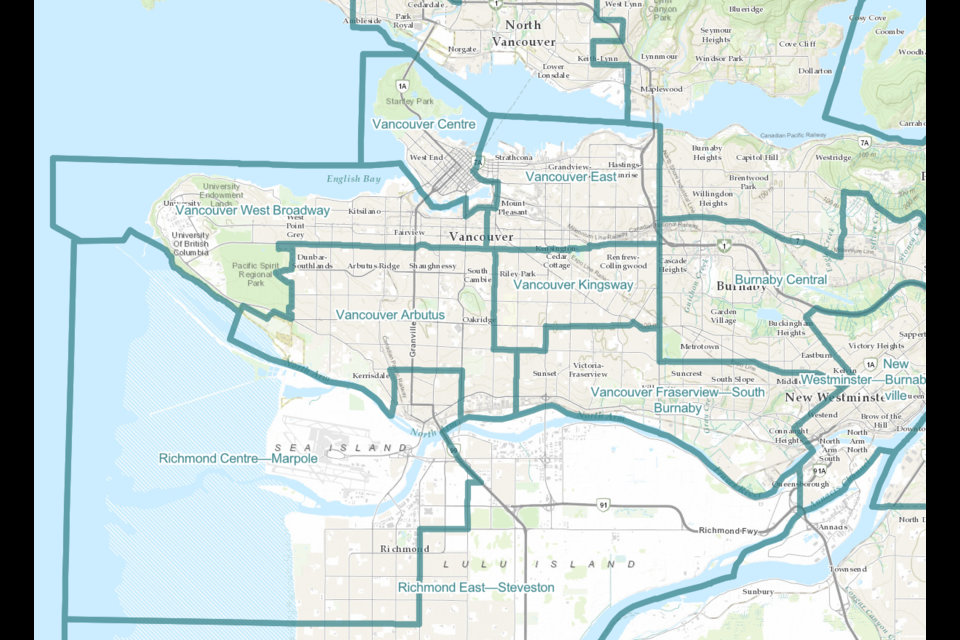Before the next Canadian election almost all of Vancouver's federal ridings are changing.
Over the past year, a federal commission has proposed new boundaries as demographics change, consulting with the public, and redrawing the ridings which MPs represent; that process is nearly at its end and the suggested boundaries have been released.
Vancouver has had six ridings since 2015, when Vancouver-Granville was created using pieces from four of the other ridings. If the proposed boundaries are approved, that will be among the changes.
The changes
For many years Vancouver's ridings have been just in Vancouver's municipal boundaries. However, the proposed boundaries will change that, as Marpole would join with part of Richmond, and the neighbourhoods of Fraserview and Killarney will join up with South Burnaby.
"It was suggested that the urban nature of Richmond Centre, the success of Canada Line transportation, and the location of two bridge crossings of the north arm of the Fraser River supported including lands in the historic Vancouver area of Marpole within the existing Richmond Centre district," reads a federal report.
While five ridings will see boundary changes, three of them are facing much more drastic changes.
The newest, Vancouver-Granville, is one of those; it's changing so much that it's being renamed Vancouver-Arbutus, arguably a whole different riding. Right now it's a very north-south riding between Arbutus Street and Main/Cambie streets with West 4th/6th/2nd as its northern boundary and the Fraser River at the south.
Vancouver-Arbutus will cover an area south of West 16th to the Fraser River, excluding Marpole, between UBC and Main and Fraser streets. This includes Shaughnessy, areas that had been part of Vancouver-Quadra (like Dunbar, Kerrisdale, and the Southlands), and parts of Vancouver-South.
A big chunk of what was Vancouver-Granville is joining up with two-thirds of Vancouver-Quadra to become Vancouver-West Broadway (incorporating UBC, Point Grey, Kitsilano, and Fairview).
In the southeast of the city, the eastern parts of Vancouver-South are joining up with the southern parts of Burnaby South to become Vancouver Fraserview-South Burnaby.
Vancouver-Kingsway isn't changing too much; the proposal suggests it gain a part of Vancouver-South bounded by East 49 Avenue, Main Street, and Knight Street.
Vancouver-Centre is arguably changing the least; the oldest continuous riding in the city, which is centered around the downtown core, is losing parts of Kitsilano and Fairview to the West Broadway riding, but it's keeping Olympic Village.
The only riding that won't change is Vancouver East, which covers the northeastern part of the city, essentially from False Creek to Boundary Road and from the Burrard Inlet to East 16th and the Grandview Highway.
Criticisms
The breaking of Vancouver-South into three ridings (eastern parts combined with South Burnaby, western parts would be in Vancouver-Arbutus, and northern parts would join Vancouver-Kingsway) has raised criticism by members of the South Asian community, which make up about 18 per cent of the riding's population.
In particular, the Punjabi Market Collective is highlighting the fact two central parts of the community would be in different ridings: the Punjabi Market neighbourhood and the Khalsa Diwan Society Gurdwara. Both are historically significant sites for the community.
"We urge the Boundaries Commission to revisit their proposal and avoid splitting our community apart," the state in a press release.
They also raise concerns about the different socio-economic groups in the ridings and losing the community's connection to the federal government.
"The priorities in Vancouver-Arbutus are completely different to the needs of working-class, racialized groups in this particular community," they note.
Why are boundaries being redrawn?
Traditionally, the boundaries are redrawn to try and keep make sure all ridings have about the same population, which right now is about 116,300. As of the most recent census, all the new ridings would be almost within two per cent of that number, with Vancouver-West Broadway at 1.73 per cent under (which means slight over-representation) and Vancouver-East at 2 per cent (which means slight under-representation).
The redrawn boundaries are also due to growing and shifting demographics. While B.C. is getting a new seat in the House of Commons, the province's newest riding won't be in the Lower Mainland; Kamloops-Shuswap-Central Rockies has been proposed as the province's 43rd riding.
What happens now?
Last month, the Federal Electoral Boundaries Commission for British Columbia sent its report to the House of Commons, where it will be reviewed and MPs can weigh in on the new boundaries. From there the report and suggested boundary changes will be sent back to the commission, along with any objections, for consideration.
The commission will then consider the objections, redraft any boundaries they believe need to be changed, and resubmit to the Speaker of the House of Commons. The new boundaries are then declared official and come into effect the next time there's a federal election.



